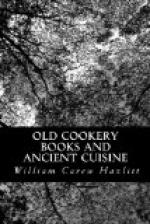As the fork grew out of the chopstick, the spoon was probably suggested by the ladle, a form of implement employed alike by the baker and the cook; for the early tool which we see in the hands of the operative in the oven more nearly resembles in the bowl a spoon than a shovel. In India nowadays they have ladles, but not spoons. The universality of broths and semi-liquid substances, as well as the commencement of a taste for learned gravies, prompted a recourse to new expedients for communicating between the platter and the mouth; and some person of genius saw how the difficulty might be solved by adapting the ladle to individual service. But every religion has its quota of dissent, and there were, nay, are still, many who professed adherence to the sturdy simplicity of their progenitors, and saw in this daring reform and the fallow blade of the knife a certain effeminate prodigality.
It is significant of the drift of recent years toward the monograph, that, in 1846, Mr. Westman published “The Spoon: Primitive, Egyptian, Roman, Mediaeval and Modern,” with one hundred illustrations, in an octavo volume.
The luxury of carving-knives was, even in the closing years of the fifteenth century, reserved for royalty and nobility; for in the “Privy Purse Expenses of Henry VII.,” under 1497, a pair is said to have cost L1 6s. 8d. of money of that day. Nothing is said of forks. But in the same account, under February 1st, 1500-1, one Mistress Brent receives 12s. (and a book, which cost the king 5s. more) for a silver fork weighing three ounces. In Newbery’s “Dives Pragmaticus,” 1563, a unique poetical volume in the library at Althorpe, there is a catalogue of cooking utensils which, considering its completeness, is worth quotation; the author speaks in the character of a chapman—one forestalling Autolycus:—
“I have basins, ewers, of tin, pewter
and glass.
Great vessels of copper, fine latten and
brass:
Both pots, pans and kettles, such as never
was.
I have platters, dishes, saucers and candle-sticks,
Chafers, lavers, towels and fine tricks:
Posnets, frying-pans, and fine puddingpricks
...
Fine pans for milk, and trim tubs for
sowse.
I have ladles, scummers, andirons and
spits,
Dripping-pans, pot-hooks....
I have fire-pans, fire-forks, tongs, trivets,
and trammels,
Roast-irons, trays, flaskets, mortars
and pestles....”
And among other items he adds rollers for paste, moulds for cooks, fine cutting knives, fine wine glasses, soap, fine salt, and candles. The list is the next best thing to an auctioneer’s inventory of an Elizabethan kitchen, to the fittings of Shakespeare’s, or rather of his father’s. A good idea of the character and resources of a nobleman’s or wealthy gentleman’s kitchen at the end of the sixteenth and commencement of the seventeenth century may be formed from the Fairfax inventories (1594-1624), lately edited by Mr. Peacock. I propose to annex a catalogue of the utensils which there present themselves:—




